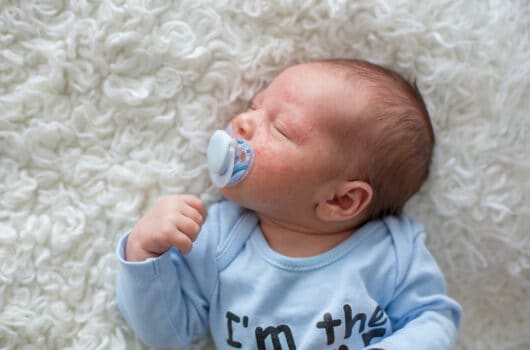Babies are known for their soft and flawless skin, which is why the sight of tiny red and white bumps can be quite concerning. In most cases, however, there’s nothing to worry about; contrary to popular belief, acne isn’t reserved for teenagers. Luckily, neonatal acne isn’t usually uncomfortable for babies and generally clears up on its own.
In this article, we cover the causes of baby acne while explaining how to treat mild cases at home. We’ll also give some tips on how to differentiate neonatal acne from other common skin conditions that affect newborns.
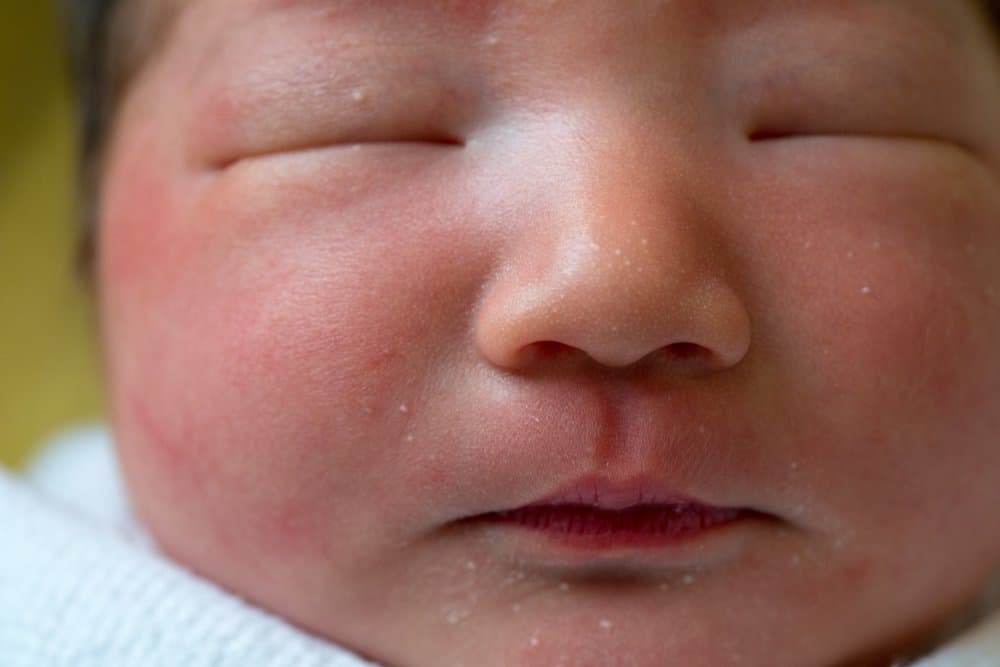
How to Identify Baby Acne (Symptoms)
Baby acne, or neonatal acne, is a common skin condition that affects newborn babies. It usually occurs during a baby’s first month of life, at around 2 to 4 weeks.
This form of acne is most commonly located on a baby’s face. Or, more specifically, on a newborn’s forehead, eyelids, nose, neck, or cheeks. But, baby acne can occur on the body, too, albeit much rarer.
If your little one’s face has a dusting of small red or white bumps, they’re probably dealing with a case of neonatal acne. But don’t worry, baby acne is very common. In fact, according to Dr. Lewis First of the University of Vermont Children’s Hospital, it affects 1 in 5 babies.
What Causes Baby Acne?
While the true cause of baby acne is unknown, pediatricians suspect that it is caused by a mother’s leftover pregnancy hormones. These hormones continue to circulate through a newborn’s bloodstream after birth, putting their oil-producing glands in overdrive.
This, and the fact that a baby’s skin is both sensitive and under-developed, causes their pores to take in excess oil and dirt, resulting in pimples. The more sensitive your baby’s skin is, the higher their chance of developing neonatal acne.
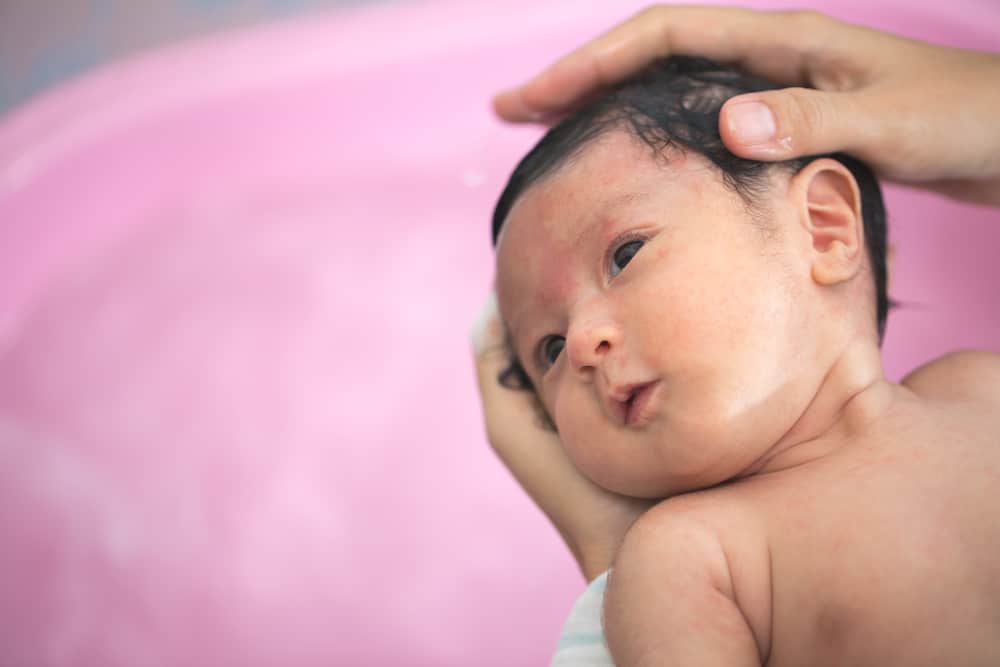
How to Treat Baby Acne at Home
Baby acne goes away on its own. Still, there are a few things parents can do (or not do) to help appease their little one’s breakouts. Below are some helpful tips to get rid of neonatal acne.
- Use warm water to gently cleanse the affected area. Repeat this 2-3 times daily. Pat the skin to dry it, paying close attention not to scrub any of the pimples.
- Avoid using harsh soaps, creams, and lotions.
- Never pick or squeeze your baby’s pimples.
If you’re interested in using a natural remedy to heal your baby’s acne, take a look at this article. It touts the use of breastmilk as the ultimate baby acne remedy, praising it for its antimicrobial properties.
How Long Does Baby Acne Last?
Baby acne usually fades away on its own after 2-4 weeks. However, some babies continue to experience acne until they reach 6 months of age. If this skin issue persists beyond this time, you may want to seek medical advice.
When to Seek Medical Help for Your Baby’s Acne
It’s very rare for baby acne to require medical attention, seeing as it is a common skin condition that goes away within a few weeks. However, it is important to monitor your baby’s skin for infection or dubious smells and discharge. If you suspect that something isn’t right, call your pediatrician immediately, especially if your child becomes feverish.
What to Expect From a Medical Appointment
To determine the best course of action, your pediatrician may ask whether your family has a history of particularly severe acne or whether your little one has come into contact with any potentially acne-causing medications (such as corticosteroids or iodine).
If you’re anxious about the appointment, it may help to prepare some of your own questions in advance. These could include:
- Is the condition likely to be temporary or chronic?
- What treatments are available?
- Will these bumps scar my baby’s skin?
Your pediatrician may send you home without further intervention if your tot’s condition is mild enough. Instead, they may prescribe a cream or medication if the bumps are unlikely to resolve without a helping hand.
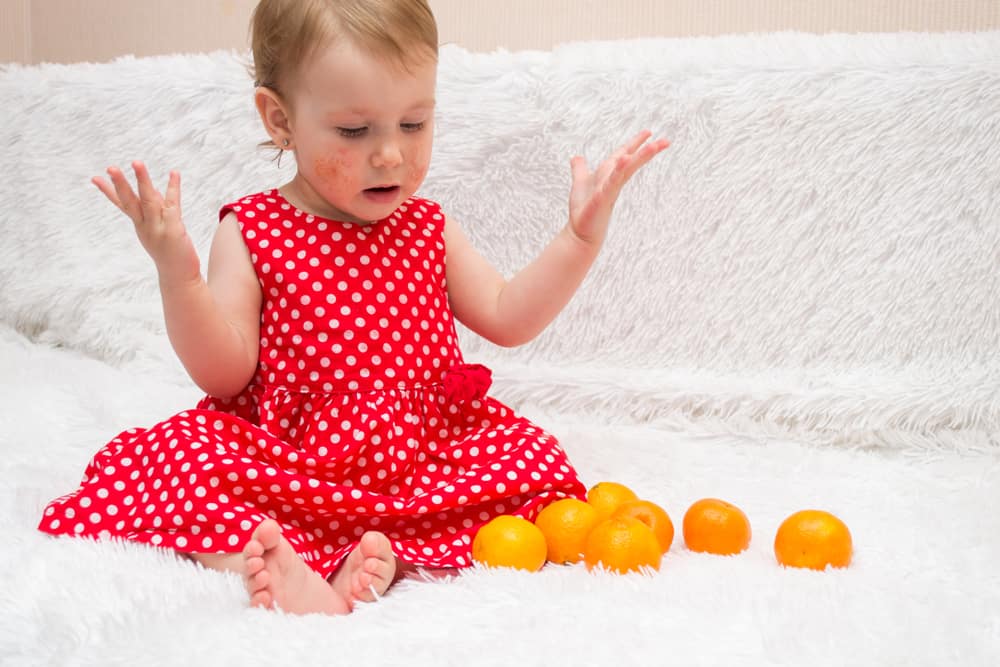
It’s Not Baby Acne — What Else Could It Be?
Newborn babies have ultra-sensitive skin, which is what makes them so vulnerable to skin conditions, like baby acne. Sometimes, however, a skin condition may appear to be neonatal acne when, in reality, it’s something else entirely. To help you pinpoint the real culprit, we listed some of the most common skin conditions for babies below.
Infantile Acne
Unlike neonatal acne, which generally goes away on its own without scarring the skin, infantile acne is more persistent and can result in scarring. You’ll know your child is dealing with infantile acne if their pimples appear more aggressive.
Infantile acne is characterized by the presence of blackheads, cysts, nodules, and whiteheads. This form of acne is commonly located on the chin, cheeks, and forehead. And, unlike baby acne, infantile acne occurs at about 6 weeks of age and can last until your little one’s second birthday.
Baby Eczema
Just like baby acne, baby eczema is a common and non-threatening skin condition that affects newborns and infants. Parents who do not know about baby acne often mistake neonatal acne for eczema. Luckily, it’s easy to spot the differences between these two skin conditions once you know what to look for.
If your baby has eczema, you’ll notice red and flaky patches around your little one’s body. This condition is not limited to the face and can occur anywhere on the body. Typically, however, these rough and itchy skin patches will form on the cheeks, arms, and legs. For more information on baby eczema and how to treat it, take a look at this article by WebMD.
Erythema Toxicum Neonatorum (ETN)
Commonly referred to as newborn rash, ETN is a common skin condition that affects up to 70% of newborns. The difference between ETN and baby acne is that the rash created by ETN resembles a cluster of fleabites: yellowish bumps surrounded by red skin. ETN isn’t dangerous and should go away on its own. It typically occurs within the first 2 weeks of birth.
Milia
Just like baby acne, milia appear on a newborn’s forehead, chin, or nose within the first few weeks of life. Milia is often mistaken for baby acne, as both these skin conditions form a white pimple over the oil glands. The difference, however, is that milia are hard to the touch and are considered as cysts instead of pimples. This skin condition usually doesn’t require treatment, unless it worsens due to skin irritation.
Cradle Cap
Cradle cap can also be mistaken for baby acne, even though it occurs on the scalp and not the skin. If your child’s scalp is dotted with crusty or oily patches, they probably have cradle cap.
It goes away on its own after a few months, but more severe cases can cause baby hair loss. You can get rid of it sooner by regularly washing your baby’s scalp with a mild shampoo.
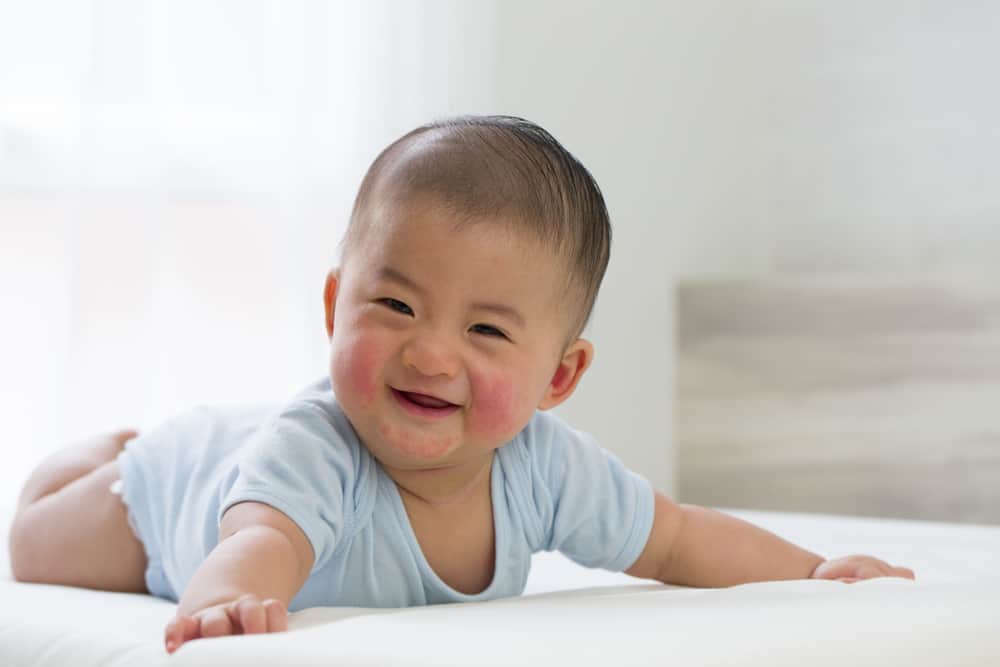
Last Thoughts
If your baby has neonatal acne, you can expect it to clear up on its own within a month. Still, it’s never a bad idea to call your pediatrician for him or her to rule out other skin conditions.
A newborn’s skin has not finished developing yet. And so, it is very vulnerable to environmental factors. Consequently, most parents will notice that their baby’s face or body has rashes or skin issues at some point or another.
Still, with a little love, care, and patience, your child’s skin will revert to its flawless self. Until they hit puberty, that is!
